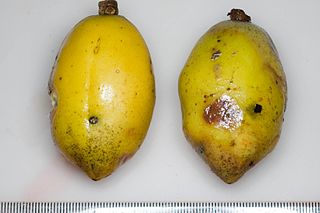
Glycydendron is a genus of plants, under the family Euphorbiaceae first described as a genus in 1922. It is native to South America.
- Glycydendron amazonicumDucke - French Guinea, Suriname, Guyana, Ecuador, Peru, Bolivia, northwestern Brazil, possibly Colombia
- Glycydendron espiritosantenseKuhlm, - State of Espirito Santo in Brazil

Jardim Botânico is a wealthy residential neighborhood of Rio de Janeiro, Brazil, located north of Ipanema and Leblon, just across Lagoa Rodrigo de Freitas and east of Gávea. Jardim Botânico lies in the South Zone of Rio de Janeiro.
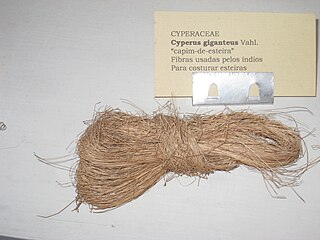
Cyperus giganteus is a perennial herbaceous plant. It belongs to the genus Cyperus. Its native range extends from Jalisco in west-central Mexico as far south as Uruguay, and also grows on some islands in the Caribbean. The species is sparingly naturalized in eastern Texas and southern Louisiana.
Jardim Botânico, Portuguese for botanical garden, may refer to:
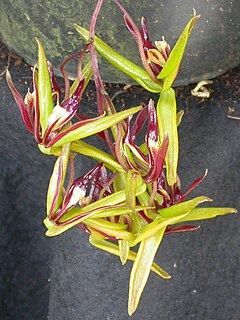
Cirrhaea is a genus of orchids, comprising 7 recognized species, all endemic to Brazil.

Amaro Macedo was a Brazilian botanist who was the best-known collector of the Brazilian Cerrado plant species of the 20th century. He lived in Ituiutaba, State of Minas Gerais, Brazil. He started his collection in 1943 when he was a teacher of Natural Sciences in the Instituto Marden, Ituiutaba. He collected most of his plant material in the cerrado vegetation of the States of Minas Gerais, Goiás, Maranhão and Pará. He collected also in the regions of the villages of Natividade, Porto Nacional and Filadelfia, at the time part of the State of Goiás, although now part of the state of Tocantins. Plant specimens from his collection are in several herbaria in Brazil and outside. Between 1943 and 2007 he collected 6,008 plant specimens, several of them are considered new species and some were named for him by fellow botanists.

Albertinia is a genus of flowering plants in the daisy family described as a genus in 1820.

Centroglossa is a genus of flowering plants from the orchid family, Orchidaceae. It contains 5 accepted species, all endemic to Brazil:
- Centroglossa castellensisBrade - Espírito Santo
- Centroglossa greeniana(Rchb.f.) Cogn. in C.F.P.von Martius - Rio de Janeiro, São Paulo
- Centroglossa macrocerasBarb.Rodr.
- Centroglossa nunes-limaePorto & Brade - Minas Gerais, Espírito Santo
- Centroglossa tripollinica(Barb.Rodr.) Barb.Rodr.

Constantia is a genus of flowering plants from the orchid family, Orchidaceae. It contains 6 known species, all endemic to Brazil:
- Constantia australis(Cogn.) Porto & Brade - Santa Catarina
- Constantia cipoensisPorto & Brade - Minas Gerais
- Constantia cristinaeF.E.L.Miranda - Minas Gerais
- Constantia gutfreundianaChiron & V.P.Castro - Minas Gerais
- Constantia microscopicaF.E.L.Miranda - Minas Gerais
- Constantia rupestrisBarb.Rodr. - Rio de Janeiro

Thysanoglossa is a genus of flowering plants from the orchid family, Orchidaceae. It contains three known species, all endemic to southeastern Brazil.

Pygmaeorchis is a genus of flowering plants from the orchid family, Orchidaceae. It contains two known species, both endemic to Brazil:
Alexander Curt Brade (1881–1971) was a German botanist who specialized in the study of the orchids and ferns of Brazil and Costa Rica.
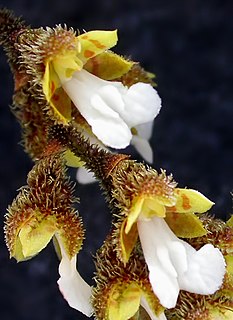
Saundersia is a genus of epiphytic orchids endemic to Brazil. It contains two species accepted as of June 2014:

Macradenia lutescens is a species of epiphytic orchid known by the common name longgland orchid. It is native to South America, the West Indies, and southern Florida.

Cunila is a genus of plants in the Lamiaceae, first described in 1759. It is native to North and South America.
- Cunila angustifoliaBenth. - southern Brazil, Misiones Province of Argentina
- Cunila crenataGarcía-Peña & Tenorio - State of Durango in Mexico
- Cunila fasciculataBenth. - southern Brazil
- Cunila galioidesBenth. - Brazil
- Cunila incanaBenth. - southern Brazil, Argentina
- Cunila incisaBenth. - southern Brazil
- Cunila leucanthaKunth ex Schltdl. & Cham. - Mexico, Central America
- Cunila lythrifoliaBenth. - central + southern Mexico
- Cunila menthiformisEpling - southern Brazil
- Cunila menthoidesBenth. - Uruguay
- Cunila microcephalaBenth. - southern Brazil, Argentina, Uruguay
- Cunila origanoides(L.) Britton - central + eastern United States from Texas and Kansas east to New York and Georgia
- Cunila platyphyllaEpling - southern Brazil
- Cunila polyanthaBenth. - Mexico, Central America
- Cunila pycnanthaB.L.Rob. & Greenm. - Mexico
- Cunila ramamoorthianaM.R.Garcia-Pena - Mexico (Guerrero)
- Cunila spicataBenth. - southern Brazil, Argentina, Uruguay, Paraguay
- Cunila tenuifoliaEpling - southern Brazil
Eriothymus is a genus of flowering plant in the family Lamiaceae, first described as a genus in 1835. It contains only one known species, Eriothymus rubiaceus. It is endemic to the State of Minas Gerais in Brazil.
Hoehnea is a genus of plants in the family Lamiaceae, first described with this name in 1939. It is native to South America, primarily southern Brazil.
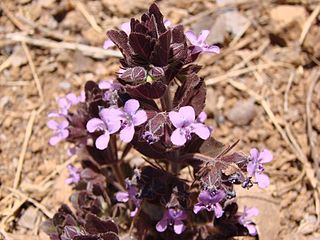
Marsypianthes is a genus of flowering plants in the family Lamiaceae, first described in 1833. It is native to South America, Central America, the West Indies, and southern Mexico.
- Marsypianthes burchelliiEpling - Brazil
- Marsypianthes chamaedrys(Vahl) Kuntze. - from southern Mexico and the West Indies south to Argentina
- Marsypianthes foliolosaBenth. - Brazil
- Marsypianthes hassleriBriq. - Paraguay, southern Brazil, Misiones Province of Argentina
- Marsypianthes montanaBenth. - Brazil
Bahiella is a genus of plants in the family Apocynaceae first described as a genus in 2006. The entire group is endemic to the State of Bahia in northeastern Brazil, the state after which the genus is named.
Kerbera is a species of plants in the Apocynaceae first described as a genus in 1885. It contains only one known species, Kerbera eichleri, endemic to the State of Rio de Janeiro in Brazil.













